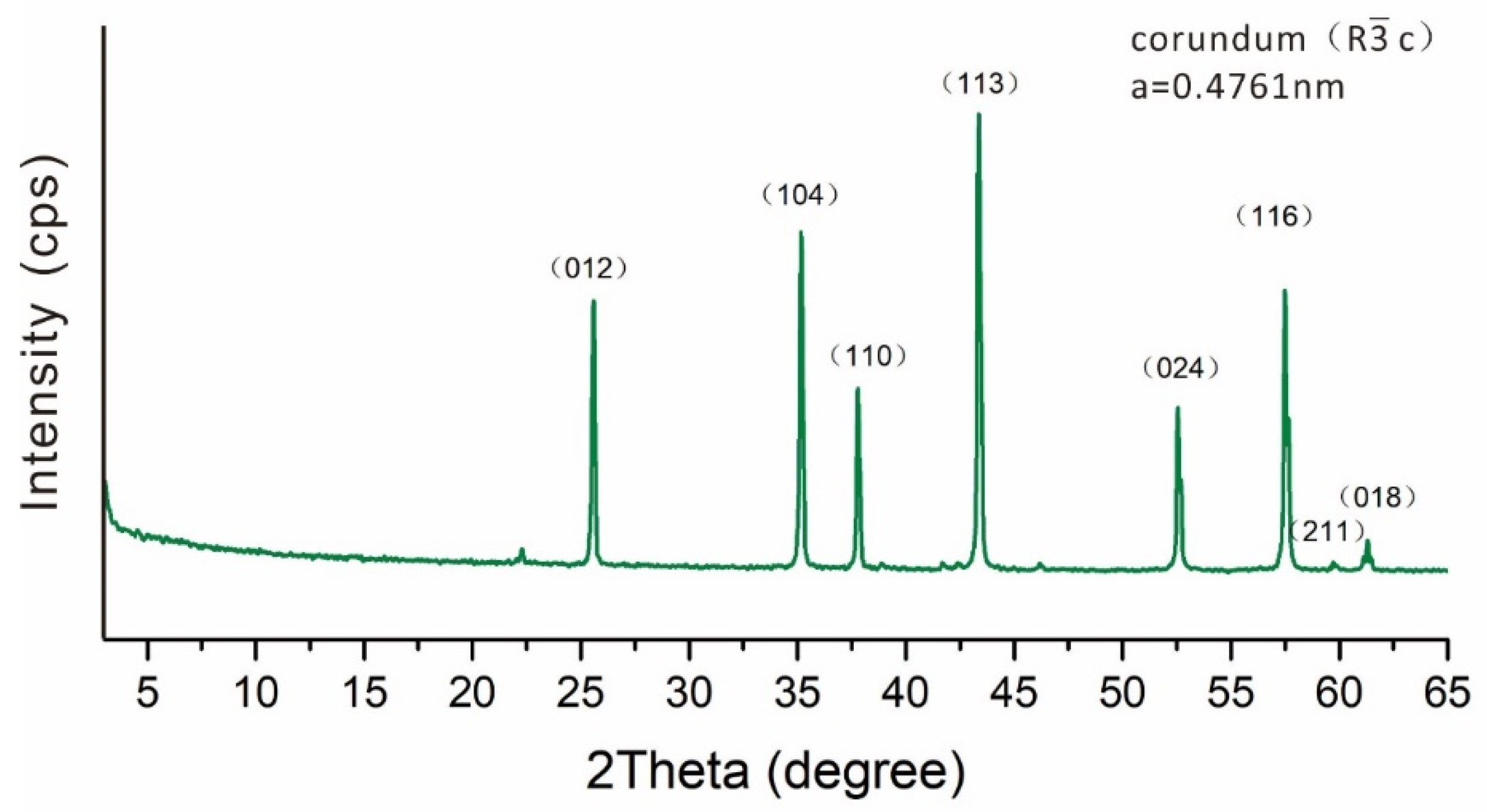Hematite Exsolutions in Corundum from Cenozoic Basalts in Changle, Shandong Province, China: Crystallographic Orientation Relationships and Interface Characters
Abstract
:1. Introduction
2. Materials and Methods
2.1. Sample Preparation
2.2. Mineralogical Compositions and Phase Identification
2.3. CORs and Interface Observation
2.3.1. EBSD Analysis
2.3.2. FIB Cut
2.3.3. HRTEM Analysis
3. Results
3.1. EPMA and XRD Results
3.2. EBSD Results
3.3. HRTEM Results
4. Discussion
4.1. Formation of Hematite in Corundum
4.2. Hematite-Corundum Interface Characters
5. Conclusions
Author Contributions
Funding
Institutional Review Board Statement
Informed Consent Statement
Data Availability Statement
Acknowledgments
Conflicts of Interest
References
- Shau, Y.; Yang, H.; Peacor, D.R. On oriented titanite and rutile inclusions in sagenitic biotite. Am. Mineral. 1991, 76, 1205–1217. [Google Scholar]
- Yui, T.; Shen, P.; Liu, H. Titanite inclusions in altered biotite from granitoids of Taiwan: Microstructures and origins. J. Asian Earth Sci. 2001, 19, 165–175. [Google Scholar] [CrossRef]
- Schmetzer, K.; Steinbach, M.P.; Gilg, H.A.; Blake, A.R. Dual-color double stars in ruby, sapphire, and quartz: Cause and historical account. Gems Gemol. 2015, 51, 112–143. [Google Scholar] [CrossRef]
- Xu, C.; Zhao, S.; Zhou, J. Crystallographic orientation of ilmenite inclusions in amphibole-an electron backscatter diffraction study. J. Appl. Crystallogr. 2020, 235, 105–116. [Google Scholar] [CrossRef]
- Hwang, S.; Yui, T.; Chu, H.; Shen, P.; Zhang, R.; Liou, J.G. An AEM study of garnet clinopyroxenite from the Sulu ultrahigh-pressure terrane: Formation mechanisms of oriented ilmenite, spinel, magnetite, amphibole and garnet inclusions in clinopyroxene. Contrib. Mineral. Petr. 2011, 161, 901–920. [Google Scholar] [CrossRef]
- Ageeva, O.; Habler, G.; Pertsev, A.; Abart, R. Fe-Ti oxide micro-inclusions in clinopyroxene of oceanic gabbro: Phase content, orientation relations and petrogenetic implication. Lithos 2017, 290, 104–115. [Google Scholar] [CrossRef]
- Hwang, S.; Shen, P.; Yui, T.; Chu, H. On the coherency-controlled growth habit of precipitates in minerals. J. Appl. Crystallogr. 2010, 43, 417–428. [Google Scholar] [CrossRef]
- Simonet, C.; Fritsch, E.; Lasnier, B. A classification of gem corundum deposits aimed towards gem exploration. Ore Geol. Rev. 2008, 34, 127–133. [Google Scholar] [CrossRef]
- Moon, A.R.; Phillips, M.R. An electron microscopy study of exsolved phases in natural black Australian sapphire. Micron Microsc. Acta 1984, 15, 143–146. [Google Scholar] [CrossRef]
- Saminpanya, S. Ti-Fe mineral inclusions in star sapphires from Thailand. Aust. Gemmol. 2001, 21, 125–128. [Google Scholar]
- He, J.; Lagerlof, K.P.D.; Heuer, A.H. Structural Evolution of TiO2 Precipitates in Ti-Doped Sapphire (α-Al2O3). J. Am. Ceram. Soc. 2011, 94, 1272–1280. [Google Scholar] [CrossRef]
- Bui, T.N.; Deliousi, K.; Malik, T.K.; De Corte, K. From exsolution to ‘gold sheen’: A new variety of corundum. J. Gemmol. 2015, 8, 678–691. [Google Scholar] [CrossRef]
- Wang, C.M.; Thevuthasan, S.; Gao, F.; McCready, D.E.; Chambers, S.A. The characteristics of interface misfit dislocations for epitaxial α-Fe2O3 on α-Al2O3 (0001). Thin Solid Films 2002, 414, 31–38. [Google Scholar] [CrossRef]
- Maheswaran, S.; Thevuthasan, S.; Gao, F.; Shutthanandan, V.; Wang, C.M.; Smith, R.J. Misfit dislocations at the single-crystal Fe2O3/Al2O3 interface. Phys. Rev. B Condens. Matter Mater. Phys. 2005, 72, 075403. [Google Scholar] [CrossRef]
- Sun, P.; Niu, Y.; Guo, P.; Ye, L.; Liu, J.; Feng, Y. Elemental and Sr–Nd–Pb isotope geochemistry of the Cenozoic basalts in Southeast China: Insights into their mantle sources and melting processes. Lithos 2017, 272, 16–30. [Google Scholar] [CrossRef] [Green Version]
- Guo, P.; Niu, Y.; Sun, P.; Gong, H.; Wang, X. Lithosphere thickness controls continental basalt compositions: An illustration using Cenozoic basalts from eastern China. Geology 2020, 48, 128–133. [Google Scholar] [CrossRef] [Green Version]
- Gao, F.; Wang, C.M.; Maheswaran, S.; Thevuthasan, S. Atomic-level simulations of misfit dislocation at the interface of Fe2O3/Al2O3 system. Nucl. Instrum. Methods Phys. Res. Sect. B Beam Interact. Mater. At. 2003, 207, 63–71. [Google Scholar] [CrossRef]
- Sutherland, F.L. Sapphire, a not so simple gemstone. Am. Mineral. 2017, 102, 1373–1374. [Google Scholar] [CrossRef]
- Liu, J.; Cao, S.; Zhou, D.; Li, X.; Wu, Y.; Wang, H.; Li, W. Characteristics and Formation of Corundum within Syenite in the Yushishan Rare Metal Deposits in the Northeastern Tibetan Plateau. Am. Mineral. 2022; in press. [Google Scholar]
- Palke, A.C.; Breeding, C.M. The origin of needle-like rutile inclusions in natural gem corundum: A combined EPMA, LA-ICP-MS, and nanoSIMS investigation. Am. Mineral. 2017, 102, 1451–1461. [Google Scholar] [CrossRef]
- Zhao, S.; Bian, Q.; Wang, Q. Crystallography and Mineralogy; Higher Education Press: Beijing, China, 2004; pp. 167–176. (In Chinese) [Google Scholar]
- Li, C.; Habler, G.; Griffiths, T.; Rečnik, A.; Jeřábek, P.; Götze, L.C.; Mangler, C.; Pennycook, T.J.; Meyer, J.; Abart, R. Structure evolution of h.c.p./c.c.p. metal oxide interfaces in solid-state reactions. Acta Crystallogr. Sect. A Found. Adv. 2018, 74, 466–480. [Google Scholar] [CrossRef] [PubMed] [Green Version]








| SiO2 | V2O3 | TiO2 | MnO | Al2O3 | Cr2O3 | FeO * | Total | |
|---|---|---|---|---|---|---|---|---|
| Core | 0.01 | 0.02 | 0 | 0 | 98.86 | 0 | 1.26 | 100.15 |
| Rim | 0.02 | 0.01 | 0 | 0.02 | 98.52 | 0 | 1.29 | 99.87 |
| 0.02 | 0.01 | 0 | 0.02 | 98.99 | 0 | 1.39 | 100.43 |
Publisher’s Note: MDPI stays neutral with regard to jurisdictional claims in published maps and institutional affiliations. |
© 2022 by the authors. Licensee MDPI, Basel, Switzerland. This article is an open access article distributed under the terms and conditions of the Creative Commons Attribution (CC BY) license (https://creativecommons.org/licenses/by/4.0/).
Share and Cite
Zhao, Q.; Zhao, S.; Xu, C. Hematite Exsolutions in Corundum from Cenozoic Basalts in Changle, Shandong Province, China: Crystallographic Orientation Relationships and Interface Characters. Crystals 2022, 12, 905. https://doi.org/10.3390/cryst12070905
Zhao Q, Zhao S, Xu C. Hematite Exsolutions in Corundum from Cenozoic Basalts in Changle, Shandong Province, China: Crystallographic Orientation Relationships and Interface Characters. Crystals. 2022; 12(7):905. https://doi.org/10.3390/cryst12070905
Chicago/Turabian StyleZhao, Qianyi, Shanrong Zhao, and Chang Xu. 2022. "Hematite Exsolutions in Corundum from Cenozoic Basalts in Changle, Shandong Province, China: Crystallographic Orientation Relationships and Interface Characters" Crystals 12, no. 7: 905. https://doi.org/10.3390/cryst12070905





